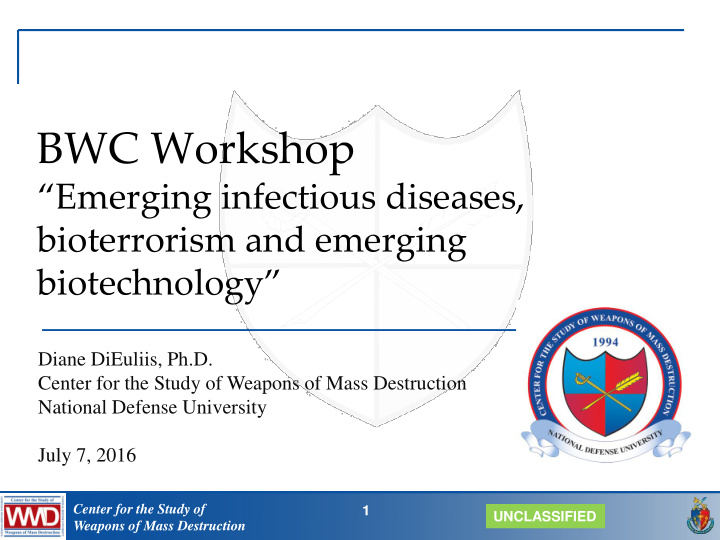



BWC Workshop “Emerging infectious diseases, bioterrorism and emerging biotechnology” Diane DiEuliis, Ph.D. Center for the Study of Weapons of Mass Destruction National Defense University July 7, 2016 Center for the Study of Center for the Study of 1 1 UNCLASSIFIED Weapons of Mass Destruction Weapons of Mass Destruction
Center for the Study of Center for the Study of 2 2 UNCLASSIFIED D. DiEuliis Weapons of Mass Destruction Weapons of Mass Destruction
(Fauci, 2016) “Deliberately Emerging” Newly Emerging Re-Emerging/Surging Center for the Study of Center for the Study of 3 3 UNCLASSIFIED D. DiEuliis Weapons of Mass Destruction Weapons of Mass Destruction
Humans and the Environment • Development/land use: increases in human/zoonotic boundaries **75% of EIDs are zoonotic • Travel/commerce: disease travels with people • Human behavior • Presence/absence of public health infrastructure Germs adapt and change naturally; bioterror agents may be altered in similar or dissimilar ways. Center for the Study of Center for the Study of 4 4 UNCLASSIFIED D. DiEuliis Weapons of Mass Destruction Weapons of Mass Destruction
Some outbreaks of 2015-2016 • Measles • Cholera • Drug resistant TB • Dengue and malaria • Zika • H7N9 flu • Yellow fever • MERS CoV • Antibiotic resistant • Chikungunya bacterial strains • Ebola Outbreaks may be select or non-select agents Center for the Study of Center for the Study of 5 5 UNCLASSIFIED D. DiEuliis Weapons of Mass Destruction Weapons of Mass Destruction
Surveillance and response EID Bioterrorism • Early detection • Early detection • Diagnostics • Diagnostics • Epidemiology • Epidemiology • Countermeasure • Countermeasure Development development • Countermeasure dispensing • Countermeasure dispensing • Communication/social • Communication/social mitigation mitigation • Attribution There is high overlap in capabilities needed to respond. Emerging biotech creates opportunities and challenges) Center for the Study of 6 Weapons of Mass Destruction
Role of emerging technology • Advances in bioinformatics: sequences can be shared more rapidly than physical samples; • Diagnostics, animal models are advanced and/or enabled by new genetic tools such as CRISPR/Cas • Vector control: better ways to sample vector populations for disease; eradication of disease from vector populations? Center for the Study of Center for the Study of 7 7 UNCLASSIFIED D. DiEuliis Weapons of Mass Destruction Weapons of Mass Destruction
CRISPR and emerging capabilities are changing the BW landscape • Ability to edit genes is getting easier, cheaper, more precise and open to wider range of actors = creation of BW (human, plant, animal, environmental) is enabled; • Novel threats enabled? • Will “bio -based ” commodities become new BW targets? • Challenges for list-based regimes for control and mitigation; • Attribution is challenged. CRISPR = “Clustered Regularly Interspaced Short Palindromic Repeats” Center for the Study of Center for the Study of 8 8 UNCLASSIFIED D. DiEuliis Weapons of Mass Destruction Weapons of Mass Destruction
Additional Observations • The WMD paradigm is not sufficient: emerging biological threats may have strategic significance without creating “mass destruction”; ability to incite fear and instability in society through perpetrated disease. • Emerging technologies could enable the specific genetic targeting of individuals or groups of people in 5-10 years. • “Human performance” enablers can alter military competitiveness. Should we re-evaluate definition of a biological WMD? Center for the Study of Center for the Study of 9 9 UNCLASSIFIED D. DiEuliis Weapons of Mass Destruction Weapons of Mass Destruction
Health Security and Nation Stability • Ensuring nations develop strong public health capacity is required for response to both EIDs and bioterror; • Health capacity contributes to overall nation stability; – Syria exemplifies; • EIDs threaten health of deployed forces and global health security as much or more as bioterror (e.g. drug resistant malaria) Center for the Study of Center for the Study of 10 10 UNCLASSIFIED D. DiEuliis Weapons of Mass Destruction Weapons of Mass Destruction
Thank you • “The international public health and emergency response architecture is in the midst of significant change right now. It is critical that the steps we take to strengthen article VII are integrated into the new architecture that emerges….efforts to assist States Parties in building their public health and response capabilities are not ‘assistance” in the sense of Article VII – but in the event of biological weapons use, may be even more valuable than response efforts after the fact.” - Amb. Wood • Questions? Center for the Study of Center for the Study of 11 11 UNCLASSIFIED D. DiEuliis Weapons of Mass Destruction Weapons of Mass Destruction
• Extra slides Center for the Study of Center for the Study of 12 12 UNCLASSIFIED D. DiEuliis Weapons of Mass Destruction Weapons of Mass Destruction
Why current biosecurity policies fall short: • Rapid pace of biotechnology – far outpaces policy development timelines; – Will stymie list-based means of controls • Capabilities are accessible to wider range of actors – emerging biotechnology is becoming ‘democratized’ – growth of DIY biology lowers barriers to entry • Gene editing tools accessible, inexpensive, efficient; • Enabling IT: DNA is increasingly easy to engineer through standards and bioinformatics Center for the Study of Center for the Study of 13 13 UNCLASSIFIED D. DiEuliis Weapons of Mass Destruction Weapons of Mass Destruction
Recommend
More recommend